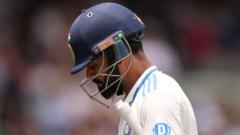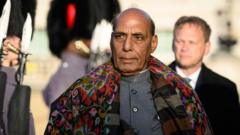Following a disheartening 1-3 loss to Australia, Indian cricket faces a critical juncture as key players struggle for form, prompting renewed scrutiny of team dynamics and future prospects ahead of their upcoming series against England.
India's Cricket Legacy in Jeopardy After Test Series Loss to Australia

India's Cricket Legacy in Jeopardy After Test Series Loss to Australia
The recent Test series defeat against Australia raises questions about the future of Indian cricket and its leadership.
Indian cricket fans are in a state of shock after their team suffered a significant 1-3 defeat in the five-match Test series against Australia, marking the end of a decade-long dominance in the Border-Gavaskar Trophy. Once regarded as near-invincible, the team's faltering performance exposed deep vulnerabilities, particularly among the batting line-up, while Jasprit Bumrah shone as the lone bowler to unsettle the Australian side.
This series loss not only resulted in the relinquishment of the prestigious Border-Gavaskar Trophy but also denied India a place in the World Test Championship (WTC) final, breaking a streak of consecutive appearances in 2021 and 2023. The downturn in form is alarming, with India losing six of their last eight Tests, including a shocking home whitewash (0-3) against New Zealand. This downturn has prompted a reevaluation of the team's depth and future prospects, particularly for captain Rohit Sharma and former captain Virat Kohli.
The upcoming five-Test series in England, set to begin in July, presents a formidable challenge. India's historical struggle in English conditions is underscored by their failure to win a series there since 2007, and the selectors now face difficult choices regarding team composition. Indeed, Sharma's paltry 31 runs in the Australian series alongside Kohli's total of 190 runs in nine innings, with most coming in a single match, raises concerns about their continued contribution.
Sharma, once a prolific run-scorer, is now grappling with his batting position, while Kohli's prolonged slump—characterized by a dismal 32-average since 2020 and limited centuries—raises alarms about his form and future. With both players underperforming, questions arise about the future landscape of Indian batting, as no clear successor to Kohli has emerged. While talents like KL Rahul, Rishabh Pant, and Shubman Gill show promise, consistency remains elusive.
The bowling unit, led by Bumrah, remains India's strength, showcasing a deep pool of fast-bowling talent. However, Bumrah, critical to the team's prospects, requires careful workload management to avoid injuries. India's spin depth faces challenges with the retirement of Ravichandran Ashwin and the mixed performance of Ravindra Jadeja.
In a bid to revitalize the team and address recent disappointments, the Indian cricket board is moving to restructure by shortlisting players from the domestic Ranji Trophy for potential selection. Both Sharma and Kohli may need to return to domestic cricket to regain their form.
Navigating a team in transition requires careful consideration and strategic thinking. While the current situation appears bleak, the wealth of young talent within Indian cricket offers hope for recovery. Drawing from history, India has previously rebounded from similar setbacks—after a whitewash in 2011, they emerged stronger, led by younger players including Kohli and Sharma.
As Indian cricket looks to its next steps, the path forward will require patience and a clear vision to harness the potential of the next generation while addressing the pressing challenges of the present.





















